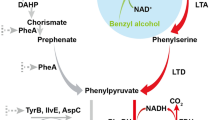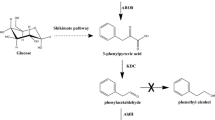Abstract
Microbial production of l-phenylalanine (l-Phe) from renewable sources has attracted much attention recently. In the present study, Corynebacterium glutamicum 13032 was rationally engineered to produce l-Phe from inexpensive glucose. First, all the l-Phe biosynthesis pathway genes were investigated and the results demonstrated that in addition to AroF and PheA, the native PpsA, TktA, AroE and AroA, and the heterologous AroL and TyrB were also the key enzymes for L-Phe biosynthesis. Through combinational expression of these key enzymes, the l-Phe production was increased to 6.33 ± 0.13 g l−1 which was about 1.48-fold of that of the parent strain C. glutamicum (pXM-pheA fbr-aroF fbr) (fbr, feedback-inhibition resistance). Furthermore, the production of l-Phe was improved to 9.14 ± 0.21 g l−1 by modifying the glucose and l-Phe transport systems and blocking the acetate and lactate biosynthesis pathways. Eventually, the titer of l-Phe was enhanced to 15.76 ± 0.23 g l−1 with a fed-batch fermentation strategy. To the best of our knowledge, this was the highest value reported in rationally engineered C. glutamicum 13032 strains. The results obtained will also contribute to rational engineering of C. glutamicum for production of other valuable aromatic compounds.




Similar content being viewed by others
References
Ahn JO, Lee HW, Saha R, Park MS, Jung JK, Lee DY (2008) Exploring the effects of carbon sources on the metabolic capacity for shikimic acid production in Escherichia coli using in silico metabolic predictions. J Microbiol Biotechnol 18:1773–1784
Ajikumar PK, Xiao WH, Tyo KE, Wang Y, Simeon F, Leonard E, Mucha O, Phon TH, Pfeifer B, Stephanopoulos G (2010) Isoprenoid pathway optimization for taxol precursor overproduction in Escherichia coli. Science 330:70–74
Backman K, O’Connor MJ, Maruya A, Rudd E, McKay D, Balakrishnan R, Radjai M, DiPasquantonio V, Shoda D, Hatch R, Venkatasubramanian K (1990) Genetic engineering of metabolic pathways applied to the production of phenylalanine. Ann N Y Acad Sci 589:16–24
Becker J, Wittmann C (2012) Bio-based production of chemicals, materials and fuels Corynebacterium glutamicum as versatile cell factory. Curr Opin Biotechnol 23:631–640
Blombach B, Schreiner ME, Moch M, Oldiges M, Eikmanns BJ (2007) Effect of pyruvate dehydrogenase complex deficiency on l-lysine production with Corynebacterium glutamicum. Appl Microbiol Biotechnol 76:615–623
Chen Y, Nielsen J (2013) Advances in metabolic pathway and strain engineering paving the way for sustainable production of chemical building blocks. Curr Opin Biotechnol 24:965–972
Date M, Itaya H, Matsui H, Kikuchi Y (2006) Secretion of human epidermal growth factor by Corynebacterium glutamicum. Lett Appl Microbiol 42:66–70
Date M, Yokoyama K, Umezawa Y, Matsui H, Kikuchi Y (2003) Production of native-type Streptoverticillium mobaraense transglutaminase in Corynebacterium glutamicum. Appl Environ Microbiol 69:3011–3014
Dell KA, Frost JW (1993) Identification and removal of impediments to biocatalytic synthesis of aromatics from d-glucose: rate-limiting enzymes in the common pathway of aromatic amino acid biosynthesis. J Am Chem Soc 115:11581–11589
Flores N, Xiao J, Berry A, Bolivar F, Valle F (1996) Pathway engineering for the production of aromatic compounds in Escherichia coli. Nat Biotechnol 14:620–623
Gopinath V, Murali A, Dhar KS, Nampoothiri KM (2012) Corynebacterium glutamicum as a potent biocatalyst for the bioconversion of pentose sugars to value-added products. Appl Microbiol Biotechnol 93:95–106
Gosset G (2009) Production of aromatic compounds in bacteria. Curr Opin Biotechnol 20:651–658
Grinter NJ (1998) Developing an l-phenylalanine process. Chemtech 28:33–37
Ikeda M (2006) Towards bacterial strains overproducing l-tryptophan and other aromatics by metabolic engineering. Appl Microbiol Biotechnol 69:615–626
Ikeda M, Katsumata R (1999) Hyperproduction of tryptophan by Corynebacterium glutamicum with the modified pentose phosphate pathway. Appl Environ Microbiol 65:2497–2502
Ikeda M, Katsumata R (1992) Metabolic engineering to produce tyrosine or phenylalanine in a tryptophan-producing Corynebacterium glutamicum strain. Appl Environ Microbiol 58:781–785
Ikeda M, Mizuno Y, Awane S, Hayashi M, Mitsuhashi S, Takeno S (2011) Identification and application of a different glucose uptake system that functions as an alternative to the phosphotransferase system in Corynebacterium glutamicum. Appl Microbiol Biotechnol 90:1443–1451
Ikeda M, Okamoto K, Katsumata R (1999) Cloning of the transketolase gene and the effect of its dosage on aromatic amino acid production in Corynebacterium glutamicum. Appl Microbiol Biotechnol 51:201–206
Ikeda M, Ozaki A, Katsumata R (1993) Phenylalanine production by metabolically engineered Corynebacterium glutamicum with the pheA gene of Escherichia coli. Appl Microbiol Biotechnol 39:318–323
Juminaga D, Baidoo EE, Redding-Johanson AM, Batth TS, Burd H, Mukhopadhyay A, Petzold CJ, Keasling JD (2012) Modular engineering of l-tyrosine production in Escherichia coli. Appl Environ Microbiol 78:89–98
Kang Z, Gao CJ, Wang QA, Liu HM, Qi QS (2010) A novel strategy for succinate and polyhydroxybutyrate co-production in Escherichia coli. Bioresour Technol 101:7675–7678
Kikuchi Y, Date M, Yokoyama K, Umezawa Y, Matsui H (2003) Secretion of active-form Streptoverticillium mobaraense transglutaminase by Corynebacterium glutamicum: processing of the pro-transglutaminase by a cosecreted subtilisin-Like protease from Streptomyces albogriseolus. Appl Environ Microbiol 69:358–366
Kim SY, Lee J, Lee SY (2014) Metabolic engineering of Corynebacterium glutamicum for the production of l-ornithine. Biotechnol Bioeng. doi:10.1002/bit.25440
Lütke-Eversloh T, Stephanopoulos G (2008) Combinatorial pathway analysis for improved l-tyrosine production in Escherichia coli: identification of enzymatic bottlenecks by systematic gene overexpression. Metab Eng 10:69–77
Li R, Chen Q, Wang PG, Qi QS (2007) A novel-designed Escherichia coli for the production of various polyhydroxyalkanoates from inexpensive substrate mixture. Appl Microbiol Biotechnol 75:1103–1109
Lindner SN, Seibold GM, Henrich A, Kramer R, Wendisch VF (2011) Phosphotransferase system-independent glucose utilization in Corynebacterium glutamicum by inositol permeases and glucokinases. Appl Environ Microbiol 77:3571–3581
Lindner SN, Seibold GM, Kramer R, Wendisch VF (2011) Impact of a new glucose utilization pathway in amino acid-producing Corynebacterium glutamicum. Bioeng Bugs 2:291–295
Liu DX, Fan CS, Tao JH, Liang GX, Gao SE, Wang HJ, Li X, Song DX (2004) Integration of E. coli aroG-pheA tandem genes into Corynebacterium glutamicum tyrA locus and its effect on l-phenylalanine biosynthesis. World J Gastroenterol 10:3683–3687
Liu LF, Martinez JL, Liu ZH, Petranovic D, Nielsen J (2014) Balanced globin protein expression and heme biosynthesis improve production of human hemoglobin in Saccharomyces cerevisiae. Metab Eng 21:9–16
Liu SP, Liu RX, Xiao MR, Zhang L, Ding ZY, Gu ZH, Shi GY (2014) A systems level engineered E. coli capable of efficiently producing L-phenylalanine. Process Biochem 49:751–757
Lu J, Tang JL, Liu Y, Zhu XN, Zhang TC, Zhang XL (2012) Combinatorial modulation of galP and glk gene expression for improved alternative glucose utilization. Appl Microbiol Biotechnol 93:2455–2462
Lu JL, Liao JC (1997) Metabolic engineering and control analysis for production of aromatics: Role of transaldolase. Biotechnol Bioeng 53:132–138
Oldiges M, Kunze M, Degenring D, Sprenger G, Takors R (2004) Stimulation, monitoring, and analysis of pathway dynamics by metabolic profiling in the aromatic amino acid pathway. Biotechnol Prog 20:1623–1633
Park JH, Lee SY (2008) Towards systems metabolic engineering of microorganisms for amino acid production. Curr Opin Biotechnol 19:454–460
Patnaik R, Liao JC (1994) Engineering of Escherichia coli central metabolism for aromatic metabolite production with near theoretical yield. Appl Environ Microbiol 60:3903–3908
Pfleger BF, Pitera DJ, Smolke CD, Keasling JD (2006) Combinatorial engineering of intergenic regions in operons tunes expression of multiple genes. Nat Biotechnol 24:1027–1032
Santos CN, Xiao WH, Stephanopoulos G (2012) Rational, combinatorial, and genomic approaches for engineering l-tyrosine production in Escherichia coli. Proc Natl Acad Sci USA 109:13538–13543
Schäfer A, Tauch A, Jäger W, Kalinowski J, Thierbach G, Pühler A (1994) Small mobilizable multi-purpose cloning vectors derived from the Escherichia coli plasmids pK18 and pK19: selection of defined deletions in the chromosome of Corynebacterium glutamicum. Gene 145(1):69–73
Tanji Y, Hattori K, Suzuki K, Miyanaga K (2008) Spontaneous deletion of a 209-kilobase-pair fragment from the Escherichia coli genome occurs with acquisition of resistance to an assortment of infectious phages. Appl Environ Microbiol 74:4256–4263
Wang D, Li QA, Yang MH, Zhang YJ, Su ZG, Xing JM (2011) Efficient production of succinic acid from corn stalk hydrolysates by a recombinant Escherichia coli with ptsG mutation. Process Biochem 46:365–371
Wang QZ, Wu CY, Chen T, Chen X, Zhao XM (2006) Expression of galactose permease and pyruvate carboxylase in Escherichia coli ptsG mutant increases the growth rate and succinate yield under anaerobic conditions. Biotechnol Lett 28:89–93
Wu JJ, Du GC, Zhou JW, Chen J (2013) Metabolic engineering of Escherichia coli for 2S-pinocembrin production from glucose by a modular metabolic strategy. Metab Eng 16:48–55
Xu DQ, Tan YZ, Huan XJ, Hu XQ, Wang XY (2010) Construction of a novel shuttle vector for use in Brevibacterium flavum, an industrial amino acid producer. J Microbiol Methods 80:86–92
Xu P, Gu Q, Wang WY, Wong L, Bower AGW, Collins CH, Koffas MA (2013) Modular optimization of multi-gene pathways for fatty acids production in E. coli. Nat Commun 4:1409
Zamboni N, Fischer E, Muffler A, Wyss M, Hohmann HP, Sauer U (2005) Transient expression and flux changes during a shift from high to low riboflavin production in continuous cultures of Bacillus subtilis. Biotechnol Bioeng 89:219–232
Zhang CZ, Kang Z, Zhang J, Du GC, Chen J, Yu XB (2014) Construction and application of novel feedback-resistant 3-deoxy-d-arabino-heptulosonate-7-phosphate synthases by engineering the N-terminal domain for l-phenylalanine synthesis. FEMS Microbiol Lett 353:11–18
Zhang CZ, Zhang JL, Kang Z, Du GC, Yu XB, Wang TW, Chen J (2013) Enhanced production of l-phenylalanine in Corynebacterium glutamicum due to the introduction of Escherichia coli wild-type gene aroH. J Ind Microbiol Biotechnol 40:643–651
Zhao Z, Ding JY, Li T, Zhou NY, Liu SJ (2011) The ncgl1108 (PheP (Cg)) gene encodes a new l-Phe transporter in Corynebacterium glutamicum. Appl Microbiol Biotechnol 90:2005–2013
Zhou HY, Liao XY, Wang TW, Du GC, Chen J (2010) Enhanced l-phenylalanine biosynthesis by co-expression of pheA fbr and aroF wt. Bioresour Technol 101:4151–4156
Zhu LW, Li XH, Zhang L, Li HM, Liu JH, Yuan ZP, Chen T, Tang YJ (2013) Activation of glyoxylate pathway without the activation of its related gene in succinate-producing engineered Escherichia coli. Metab Eng 20:9–19
Acknowledgments
This work was financially supported by the Key Program of the National Natural Science Foundation of China (973 Program, 2014CB745103, 2013CB733602), the National Natural Science Foundation of China (31200020), the Jiangsu Planned Projects for Postdoctoral Research Funds (1301010B), the 111 Project and the Priority Academic Program Development of Jiangsu Higher Education Institutions and the Self-determined Research Program of Jiangnan University (JUSRP51303A).
Author information
Authors and Affiliations
Corresponding author
Electronic supplementary material
Below is the link to the electronic supplementary material.
Rights and permissions
About this article
Cite this article
Zhang, C., Zhang, J., Kang, Z. et al. Rational engineering of multiple module pathways for the production of l-phenylalanine in Corynebacterium glutamicum . J Ind Microbiol Biotechnol 42, 787–797 (2015). https://doi.org/10.1007/s10295-015-1593-x
Received:
Accepted:
Published:
Issue Date:
DOI: https://doi.org/10.1007/s10295-015-1593-x




